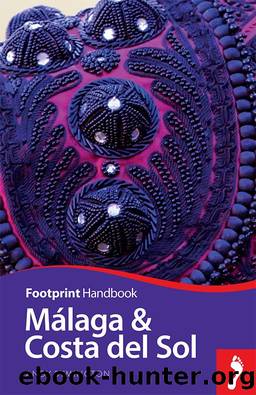Footprint Málaga & Costa del Sol by Andy Symington

Author:Andy Symington
Language: spa
Format: epub
Publisher: Footprinttravelguides
Published: 2004-07-15T00:00:00+00:00
In the 15th century, there were regular rebellions and much kinstrife over succession in the Nasrid kingdom, which was beginning to seem ripe for the plucking. One of the reasons this hadn’t yet happened was that the Christian kingdoms were involved in similar succession disputes. Then, in 1469, an event occurred that was to spell the end for the Moorish kingdom and have a massive impact on the history of the world. The heir to the Aragonese throne, Fernando, married Isabel, heiress of Castilla, in a secret ceremony in Valladolid. The implications were enormous. Aragón was still a power in the Mediterranean (Fernando was also king of Sicily) and Castilla’s domain covered much of the peninsula. The unification under the Reyes Católicos, as the monarchs became known, marked the beginnings of Spain as we know it today. Things didn’t go smoothly at first, however. There were plenty of opponents to the union and forces in support of Juana, Isabel’s elder (but claimed by her to be illegitimate) sister waged wars across Castilla.
When the north was once more at peace, the monarchs found that they ruled the entire peninsula except for Portugal, with which a peace had just been negotiated, the small mountain kingdom of Navarra, which Fernando stood a decent chance of inheriting at some stage anyway, and the decidedly un-Catholic Nasrids in their sumptuous southern palaces. The writing was on the wall and Fernando and Isabel began their campaign. Taking Málaga in 1487 and Almería in 1490, they were soon at Granada’s gates. The end came with a whimper, as the vacillating King Boabdil, who had briefly allied himself with the monarchs in a struggle against his father, elected not to go down fighting and surrendered the keys of the great city on New Year’s Day in 1492 in exchange for a small principality in the Alpujarra region (which in the end he decided not to take and left for Morocco). His mother had little sympathy as he looked back longingly at the city he had left. “You weep like a woman,” she allegedly scolded, “for what you could not defend like a man”.
The Catholic Monarchs had put an end to Al-Andalus, which had endured in various forms for the best part of 800 years. They celebrated in true Christian style by kicking the Jews out of Spain. Andalucía’s Jewish population had been hugely significant for a millennium and a half, heavily involved in commerce, shipping and literature throughout the peninsula. But hatred of them had begun to grow in the 14th century and there had been many pogroms, including an especially vicious one in 1391, which began in Sevilla and spread to most other cities in Christian Spain. Many converted during these years to escape the murderous atmosphere; they became known as conversos. The decision to expel those who hadn’t converted was far more that of the pious Isabel than the pragmatic Fernando and has to be seen in the light of the paranoid Christianizing climate. The Jews
Download
This site does not store any files on its server. We only index and link to content provided by other sites. Please contact the content providers to delete copyright contents if any and email us, we'll remove relevant links or contents immediately.
Rick Steves Spain 2017 by Rick Steves(482)
EL PEREGRINO(380)
Barcelona a photographic tour (Photographic tours Book 2) by Alexandru Ciobanu(380)
The Rough Guide to Portugal (Travel Guide eBook) by Rough Guides(377)
The Land of The Blessed Virgin by W. Somerset Maugham(374)
Michelin Green Guide Spain by Michelin(372)
The Everything Essential Spanish Book by Julie Gutin(369)
My Midsummer Morning by Alastair Humphreys(362)
Rick Steves Spain 2020 by Rick Steves(335)
Pocket Rough Guide Lisbon (Travel Guide eBook) by Rough Guides(326)
THE EVERYTHING® SPANISH VERB BOOK by Laura K. Lawless(312)
Rick Steves Barcelona by Rick Steves(296)
Insight Guides Pocket Spain (Travel Guide eBook) by Insight Guides(279)
The Everything® Spanish Phrase Book by Cari Luna(278)
Mission Barcelona: A Scavenger Hunt Adventure (Travel Book For Kids) by Catherine Aragon(276)
Two Wheels Over Catalonia - Cycling the Back-Roads of North-Eastern Spain by Richard Guise(268)
The Reluctant Expat: Part Four - Settling Down by Alan Laycock(262)
Rick Steves' Portugal by Rick Steves(259)
Unlocking Spanish with Paul Noble: Your key to language success (Spanish Edition) by Paul Noble(257)
